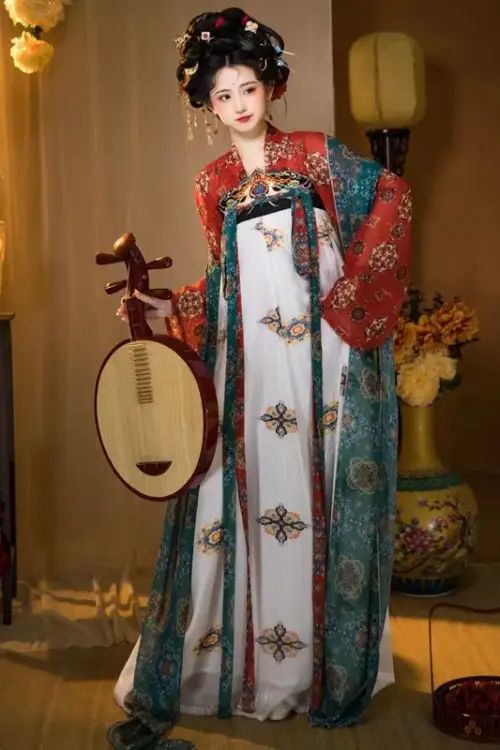The Origins and Symbolism of Lantern Patterns on Hanfu
The evolution of lantern patterns on Hanfu, the traditional clothing of the Han Chinese, reflects the rich cultural heritage and artistic ingenuity of the Chinese people. These patterns, which adorn the garments with intricate designs, have undergone significant transformations over centuries, reflecting changes in aesthetics, beliefs, and social customs.

Early Uses and Symbolism
In ancient China, lanterns were primarily used for illumination and were often associated with festivals and celebrations. As Hanfu evolved, lantern patterns began to appear on garments, symbolizing good fortune, prosperity, and the warding off of evil spirits. Early patterns were simple and geometric, featuring circles, squares, and triangles.
Han Dynasty (206 BCE – 220 CE)
During the Han dynasty, lantern patterns became more elaborate, incorporating auspicious symbols such as dragons, phoenixes, and mythical beasts. These patterns were believed to bring power, protection, and longevity to the wearer. The use of lantern patterns also became more widespread, with specific patterns associated with different social classes and occasions.
Tang Dynasty (618 – 907 CE)
In the Tang dynasty, lantern patterns reached a peak of sophistication. Artisans employed a wide range of techniques, including embroidery, weaving, and printing, to create intricate and colorful designs. Lantern patterns became an integral part of Hanfu, reflecting the cosmopolitan and opulent nature of the Tang era.
Song Dynasty (960 – 1279 CE)
During the Song dynasty, lantern patterns became more subdued and refined. Auspicious symbols continued to be used, but were often incorporated into naturalistic designs featuring flowers, birds, and landscapes. This shift reflected the growing emphasis on literati culture and the appreciation of nature.
Ming Dynasty (1368 – 1644 CE)
Lantern patterns during the Ming dynasty became more standardized and were often used to denote the wearer’s rank and status. While auspicious symbols remained prevalent, they were frequently combined with decorative elements. Patterns also became more symmetrical and balanced, mirroring the formal and hierarchical nature of Ming society.
Qing Dynasty (1644 – 1912 CE)
The Qing dynasty saw a decline in the use of lantern patterns on Hanfu. However, they remained prevalent on ceremonial garments and other textiles. In the 20th century, there was a revival of traditional Chinese culture, and lantern patterns once again became popular on Hanfu.
Modern Interpretations
Today, lantern patterns on Hanfu symbolize the enduring legacy of Chinese art and design. They continue to be used in traditional and modern garments, representing cultural pride and history.
The Evolution of Lantern Patterns through Different Hanfu Dynasties
Han Dynasty (206 BCE – 220 CE)
Lantern patterns during the Han dynasty were simple, often using geometric designs such as circles, squares, and triangles. These shapes were inspired by ancient coins and auspicious symbols, providing protection and good fortune to the wearer.
Three Kingdoms Period (220 – 280 CE)
As the Han dynasty transitioned into the Three Kingdoms period, patterns became more elaborate. The influence of Buddhism and Taoism introduced religious symbols such as lotus flowers, dragons, and phoenixes, representing purity, prosperity, and power.
Tang Dynasty (618 – 907 CE)
The Tang dynasty marked a high point for lantern patterns. Cultural exchange with foreign lands introduced Persian and Indian floral designs, creating vibrant, intricate patterns. These motifs reflected the cosmopolitan nature of the Tang era.

Song Dynasty (960 – 1279 CE)
In the Song dynasty, lantern patterns became more elegant and naturalistic. Designs of flowers, birds, and landscapes dominated, embodying the dynasty’s emphasis on nature and harmony. The patterns were often meticulously embroidered to capture a sense of realism.
Ming Dynasty (1368 – 1644 CE)
During the Ming dynasty, lantern patterns became more stylized. Geometric and auspicious symbols were combined with floral and animal motifs. Gold and silver threads added to the luxury, reflecting the status of the wearer.
Qing Dynasty (1644 – 1912 CE)
Lantern patterns in the Qing dynasty became more standardized. New symbols such as the “shou” (longevity) and “fu” (happiness) characters were introduced, symbolizing specific virtues. Though less varied, these patterns remained popular in ceremonial attire.
The Cultural Significance and Modern Interpretations of Lantern Patterns on Hanfu
Lanterns as Cultural Symbols
Lanterns, symbols of illumination and prosperity, have long been associated with Chinese festivals. On Hanfu, lantern patterns carry deep cultural significance. These designs often feature auspicious symbols like dragons and phoenixes, representing prosperity and protection.

Influence of the Ming and Qing Dynasties
The lantern festival became popular during the Ming dynasty, and its patterns were incorporated into Hanfu. By the Qing dynasty, these patterns became more elaborate, drawing on both local and foreign influences. Elements like bright colors and metallic threads enhanced the opulence of the garments.
Modern Reinterpretations
In the 20th century, lantern patterns experienced a resurgence in popularity as part of the revival of traditional Chinese culture. Modern designers have embraced these motifs, blending them with contemporary fashion. Lantern-patterned Hanfu garments are now worn for special occasions, continuing the legacy of Chinese cultural heritage.
Symbolic Legacy
Today, the lantern pattern is not just a decorative element on Hanfu but a symbol of cultural identity, history, and creativity. It represents the hopes and dreams of the Chinese people, bridging past traditions with modern interpretations.
